Novel Trends in the Development of Surfactant-Based Hydraulic Fracturing Fluids: A Review
Abstract
:1. Introduction
- (1)
- Form a stable proppant suspension, prevent its sedimentation, and efficiently transport it into the fracture, which is achieved by high viscosity and elasticity;
- (2)
- Be easily pumped into the wellbore with a minimal pressure drop, for which shear thinning behavior is important;
- (3)
- Pass through perforations without degradation of the mechanical properties, for which recovery after high shear is necessary;
- (4)
- Have sufficient temperature resistance, e.g., not degrade viscosity upon heating to reservoir temperatures;
- (5)
- Show sufficient salt tolerance, e.g., dissolve in water in the presence of salts (e.g., sodium, calcium and magnesium chlorides, or sulfates);
- (6)
- Be easily cleaned out from fracture after it is created, for which the fluids should decrease the viscosity and elasticity under the action of an external stimulus (breaker) or upon contact with reservoir hydrocarbons;
- (7)
- Not damage the formation;
- (8)
- Be compatible with the formation;
- (9)
- Have minimal environmental impact.
2. General Concepts of VES-Based Fluids
3. Advantages and Limitations of VES-Based Fluids
4. Oligomeric Surfactants
5. Mixtures
5.1. Single-Chain Surfactants
5.2. Oligomeric and Single-Chain Surfactants
5.3. Multiple Oligomeric Surfactants
5.4. “Pseudo-Oligomeric” Surfactants
6. Nanoparticle-Enhanced VES Fluids
7. Hybrid Polymer–VES Fluids
7.1. Interaction of Polymers with VES
7.2. HM-Polymers/VES
7.2.1. HM PAAm/Surfactants
7.2.2. Other Synthetic HM Polymers/Surfactants
7.2.3. Natural HM Polymers/Surfactants
7.2.4. HM Polymers/Surfactants/Nanoparticles
7.3. Hydrophilic Polymers/VES
8. Conclusions and Outlook
Author Contributions
Funding
Institutional Review Board Statement
Informed Consent Statement
Conflicts of Interest
Abbreviations
| Abbreviation | Expansion |
| CMC | critical micelle cocentration |
| CMHPG | carboxymethyl hydroxypropyl guar |
| CNF | cellulose nanofibrils |
| CTAB | cetyltrimethylammonium bromide |
| EDAA | N-erucamidopropyl-N,N-dimethyl-N-allylammonium bromide |
| EHAC | erucyl bis-(hydroxyethyl)methylammonium chloride |
| EOR | enhanced oil recovery |
| HM PAA | hydrophobically modified polyacrylic acid |
| HM PAAm | hydrophobically modified polyacrylamide |
| HM HPG | hydrophobically modified hydroxypropyl guar |
| HPGNaSal | hydroxypropyl guarsodium salicylate |
| NP | nanoparticle |
| PSS | sodium polystyrenesulfonate |
| SDS | sodium dodecyl sulfate |
| SOMT | sodium oleoyl methyl taurate |
| TMPDA | N,N,N′,N′-tetramethyl-1,3-propanediamine |
| VES | viscoelastic surfactant |
| WLM | wormlike micelle |
References
- Alvarado, V.; Manrique, E. Enhanced oil recovery: An update review. Energies 2010, 3, 1529–1575. [Google Scholar] [CrossRef]
- Economides, M.J.; Nolte, K.G. Reservoir Stimulation, 3rd ed.; Wiley: New York, NY, USA; Chinchester, UK, 2000. [Google Scholar]
- Osiptsov, A.A. Fluid mechanics of hydraulic fracturing: A review. J. Pet. Sci. Eng. 2017, 156, 513–535. [Google Scholar] [CrossRef]
- Kalam, S.; Afagwu, C.; Al Jaberi, J.; Siddig, O.M.; Tariq, Z.; Mahmoud, M.; Abdulraheem, A. A review on non-aqueous fracturing techniques in unconventional reservoirs. J. Nat. Gas Sci. Eng. 2021, 95, 104223. [Google Scholar] [CrossRef]
- Fink, J. Petroleum Engineer’s Guide to Oil Field Chemicals and Fluids; Elsevier: Amsterdam, The Netherlands, 2012. [Google Scholar]
- Barati, R.; Liang, J.-T. A review of fracturing fluid systems used for hydraulic fracturing of oil and gas wells. J. Appl. Polym. Sci. 2014, 131, 40735. [Google Scholar] [CrossRef]
- Montgomery, C. Fracturing Fluids. In Effective and Sustainable Hydraulic Fracturing; InTech Open: Rijeka, Croatia, 2013; Chapter 1. [Google Scholar]
- Al-Muntasheri, G.A. A critical review of hydraulic-fracturing fluids for moderate- to ultralow-permeability formations over the last decade. SPE Prod. Oper. 2014, 29, 243–260. [Google Scholar] [CrossRef]
- Cao, X.; Shi, Y.; Li, W.; Zeng, P.; Zheng, Z.; Feng, Y.; Yin, H. Comparative studies on hydraulic fracturing fluids for high-temperature and high-salt oil reservoirs: Synthetic polymer versus guar gum. ACS Omega 2021, 6, 25421–25429. [Google Scholar] [CrossRef]
- Xia, S.; Zhang, L.; Davletshin, A.; Li, Z.; You, J.; Tan, S. Application of polysaccharide biopolymer in petroleum recovery. Polymers 2020, 12, 1860. [Google Scholar] [CrossRef]
- Harris, P.C. Chemistry and rheology of borate-crosslinked fluids at temperatures to 300F. J. Pet. Technol. 1993, 45, 264–269. [Google Scholar] [CrossRef]
- Holtsclaw, J.; Funkhouser, G.P. A Crosslinkable synthetic-polymer system for high-temperature hydraulic-fracturing applications. SPE Drill. Complet. 2010, 25, 555–563. [Google Scholar] [CrossRef]
- Cadix, A.; Wilson, J.; Carouhy, T.; Harrisson, S.; Guichon, H. A new class of associative polymer for hydraulic fracturing applications. In Proceedings of the SPE European Formation Damage Conference and Exhibition, Budapest, Hungary, 3 June 2015. [Google Scholar] [CrossRef]
- Wei, B.; Romero-Zerón, L.; Rodrigue, D. Mechanical properties and flow behavior of polymers for enhanced oil recovery. J. Macromol. Sci. Part B 2014, 53, 625–644. [Google Scholar] [CrossRef]
- Al-Muntasheri, G.A.; Li, L.; Liang, F.; Gomaa, A.M. Concepts in cleanup of fracturing fluids used in conventional reservoirs: A literature review. SPE Prod. Oper. 2018, 33, 196–213. [Google Scholar] [CrossRef]
- Li, Q.; Xing, H.; Liu, J.; Liu, X. A review on hydraulic fracturing of unconventional reservoir. Petroleum 2015, 1, 8–15. [Google Scholar] [CrossRef] [Green Version]
- Kang, W.; Mushi, S.J.; Yang, H.; Wang, P.; Hou, X. Development of smart viscoelastic surfactants and its applications in fracturing fluid: A review. J. Pet. Sci. Eng. 2020, 190, 107107. [Google Scholar] [CrossRef]
- Pal, N.; Verma, A. Applications of surfactants as fracturing fluids: Chemical design, practice, and future prospects in oilfield stimulation operations. In Surfactants in Upstream E & P; Solling, T., Kamal, M.S., Hussain, S.M.S., Eds.; Springer International Publishing: Cham, Switzerland, 2021; pp. 331–355. [Google Scholar]
- Sullivan, P.; Nelson, E.B.; Anderson, V.; Hudges, T. Giant Micelles: Properties and Applications; CRC Press: Boca Raton, FL, USA, 2002; pp. 453–472. [Google Scholar]
- Samuel, M.M.; Card, R.J.; Nelson, E.B.; Brown, J.E.; Vinod, P.S.; Temple, H.L.; Qu, Q.; Fu, D.K. Polymer-free fluid for fracturing applications. SPE Drill. Complet. 1999, 14, 240–246. [Google Scholar] [CrossRef]
- Chase, B.; Chmilowski, W.; Marcinew, R.; Mitchell, C.; Dang, Y.; Krauss, D.; Nelson, E.; Lantz, T.; Parham, C.; Plummer, J. Clear fracturing fluids for increased well productivity. Oilfield Rev. 1997, 9, 20–33. [Google Scholar]
- Samuel, M.; Polson, D.; Graham, D.; Kordziel, W.; Waite, T.; Waters, G.; Vinod, P.; Fu, D.; Downey, R. Viscoelastic surfactant fracturing fluids: Applications in low permeability reservoirs. In Proceedings of the SPE Rocky Mountain Regional/Low-Permeability Reservoirs Symposium and Exhibition, Denver, CO, USA, 12–15 March 2000. [Google Scholar] [CrossRef]
- Yang, X.; Mao, J.; Chen, Z.; Chen, Y.; Zhao, J. Clean fracturing fluids for tight reservoirs: Opportunities with viscoelastic surfactant. Energy Sources Part A Recover. Util. Environ. Eff. 2018, 41, 1446–1459. [Google Scholar] [CrossRef]
- Hull, K.; Sayed, M.; Al-Muntasheri, G.A. Recent advances in viscoelastic surfactants for improved production from hydrocarbon reservoirs. SPE J. 2016, 21, 1340–1357. [Google Scholar] [CrossRef]
- Dreiss, C.A. Wormlike micelles: Where do we stand? Recent developments, linear rheology and scattering techniques. Soft Matter 2007, 3, 956–970. [Google Scholar] [CrossRef]
- Mitchell, D.J.; Ninham, B.W. Micelles, vesicles and microemulsions. J. Chem. Soc. Faraday Trans. 2 1981, 77, 601–629. [Google Scholar] [CrossRef]
- Magid, L.J. The surfactant−polyelectrolyte analogy. J. Phys. Chem. B 1998, 102, 4064–4074. [Google Scholar] [CrossRef]
- Rehage, H.; Hoffmann, H. Viscoelastic surfactant solutions: Model systems for rheological research. Mol. Phys. 1991, 74, 933–973. [Google Scholar] [CrossRef]
- Wang, J.; Feng, Y.; Agrawal, N.R.; Raghavan, S.R. Wormlike micelles versus water-soluble polymers as rheology-modifiers: Similarities and differences. Phys. Chem. Chem. Phys. 2017, 19, 24458–24466. [Google Scholar] [CrossRef] [PubMed]
- Raghavan, S.R.; Kaler, E.W. Highly viscoelastic wormlike micellar solutions formed by cationic surfactants with long unsaturated tails. Langmuir 2001, 17, 300–306. [Google Scholar] [CrossRef]
- Croce, V.; Cosgrove, T.; Maitland, G.; Hughes, T.; Karlsson, G. Rheology, cryogenic transmission electron spectroscopy, and small-angle neutron scattering of highly viscoelastic wormlike micellar solutions. Langmuir 2003, 19, 8536–8541. [Google Scholar] [CrossRef]
- Croce, V.; Cosgrove, T.; Dreiss, C.A.; Maitland, G.; Hughes, T. Mixed spherical and wormlike micelles: A contrast-matching study by small-angle neutron scattering. Langmuir 2004, 20, 9978–9982. [Google Scholar] [CrossRef] [PubMed]
- Raghavan, S.R.; Fritz, A.G.; Kaler, E.W. Wormlike micelles formed by synergistic self-assembly in mixtures of anionic and cationic surfactants. Langmuir 2002, 18, 3797–3803. [Google Scholar] [CrossRef]
- Ali, A.A.; Makhloufi, R. Effect of organic salts on micellar growth and structure studied by rheology. Colloid Polym. Sci. 1999, 277, 270–275. [Google Scholar] [CrossRef]
- Hartmann, V.; Cressely, R. Linear and non linear rheology of a wormlike micellar system in presence of sodium tosylate. Rheol. Acta 1998, 37, 115–121. [Google Scholar] [CrossRef]
- Hassan, P.A.; Raghavan, A.S.R.; Kaler, E.W. Microstructural changes in SDS micelles induced by hydrotropic salt. Langmuir 2002, 18, 2543–2548. [Google Scholar] [CrossRef]
- Flood, C.; Dreiss, C.A.; Croce, V.; Cosgrove, T.; Karlsson, G. Wormlike micelles mediated by polyelectrolyte. Langmuir 2005, 21, 7646–7652. [Google Scholar] [CrossRef]
- Kumar, R.; Kalur, G.C.; Ziserman, L.; Danino, D.; Raghavan, S. Wormlike micelles of a C22-tailed zwitterionic betaine surfactant: From viscoelastic solutions to elastic gels. Langmuir 2007, 23, 12849–12856. [Google Scholar] [CrossRef]
- Chu, Z.; Feng, Y.; Su, X.; Han, Y. Wormlike micelles and solution properties of a C22-tailed amidosulfobetaine surfactant. Langmuir 2010, 26, 7783–7791. [Google Scholar] [CrossRef]
- Bai, Y.; Liu, S.; Liang, G.; Liu, Y.; Chen, Y.; Bao, Y.; Shen, Y. Wormlike micelles properties and oil displacement efficiency of a salt-tolerant C22-tailed amidosulfobetaine surfactant. Energy Explor. Exploit. 2021, 39, 1057–1075. [Google Scholar] [CrossRef]
- Imanishi, K.; Einaga, Y. Wormlike micelles of polyoxyethylene alkyl ether mixtures C10E5 + C14E5 and C14E5 + C14E7: Hydrophobic and hydrophilic chain length dependence of the micellar characteristics. J. Phys. Chem. B 2007, 111, 62–73. [Google Scholar] [CrossRef]
- Wang, J.; Zhang, Y.; Chu, Z.; Feng, Y. Wormlike micelles formed by ultra-long-chain nonionic surfactant. Colloid Polym. Sci. 2021, 299, 1295–1304. [Google Scholar] [CrossRef]
- Sato, T.; Acharya, D.P.; Kaneko, M.; Aramaki, K.; Singh, Y.; Ishitobi, M.; Kunieda, H. Oil-induced structural change of wormlike micelles in sugar surfactant systems. J. Dispers. Sci. Technol. 2006, 27, 611–616. [Google Scholar] [CrossRef]
- Acharya, D.P.; Kunieda, H. Formation of viscoelastic wormlike micellar solutions in mixed nonionic surfactant systems. J. Phys. Chem. B 2003, 107, 10168–10175. [Google Scholar] [CrossRef]
- Cates, M.E.; Candau, S.J. Statics and dynamics of worm-like surfactant micelles. J. Phys. Condens. Matter 1990, 2, 6869–6892. [Google Scholar] [CrossRef]
- McCoy, T.; King, J.P.; Moore, J.E.; Kelleppan, V.T.; Sokolova, A.; de Campo, L.; Manohar, M.; Darwish, T.; Tabor, R.F. The effects of small molecule organic additives on the self-assembly and rheology of betaine wormlike micellar fluids. J. Colloid Interface Sci. 2019, 534, 518–532. [Google Scholar] [CrossRef]
- Fieber, W.; Scheklaukov, A.; Kunz, W.; Pleines, M.; Benczédi, D.; Zemb, T. Towards a general understanding of the effects of hydrophobic additives on the viscosity of surfactant solutions. J. Mol. Liq. 2021, 329, 115523. [Google Scholar] [CrossRef]
- Shibaev, A.V.; Tamm, M.V.; Molchanov, V.S.; Rogachev, A.V.; Kuklin, A.I.; Dormidontova, E.E.; Philippova, O.E. How a viscoelastic solution of wormlike micelles transforms into a microemulsion upon absorption of hydrocarbon: New insight. Langmuir 2014, 30, 3705–3714. [Google Scholar] [CrossRef]
- Shibaev, A.V.; Aleshina, A.L.; Arkharova, N.A.; Orekhov, A.S.; Kuklin, A.I.; Philippova, O.E. Disruption of cationic/anionic viscoelastic surfactant micellar networks by hydrocarbon as a basis of enhanced fracturing fluids clean-up. Nanomaterials 2020, 10, 2353. [Google Scholar] [CrossRef]
- Kamal, M.S. A review of gemini surfactants: Potential application in enhanced oil recovery. J. Surfactants Deterg. 2015, 19, 223–236. [Google Scholar] [CrossRef]
- Zana, R. Dimeric and oligomeric surfactants. Behavior at interfaces and in aqueous solution: A review. Adv. Colloid Interface Sci. 2002, 97, 205–253. [Google Scholar] [CrossRef]
- In, M.; Bec, V.; Aguerre-Chariol, O.; Zana, R. Quaternary ammonium bromide surfactant oligomers in aqueous solution: Self-association and microstructure. Langmuir 2000, 16, 141–148. [Google Scholar] [CrossRef]
- Sun, Y.; Han, F.; Zhou, Y.; Xu, B. Synthesis and properties of quaternary ammonium gemini surfactants with hydroxyethyl at head groups. J. Surfactants Deterg. 2019, 22, 675–681. [Google Scholar] [CrossRef]
- Maiti, P.K.; Lansac, Y.; Glaser, M.A.; Clark, N.; Rouault, Y. Self-assembly in surfactant oligomers: A coarse-grained description through molecular dynamics simulations. Langmuir 2002, 18, 1908–1918. [Google Scholar] [CrossRef]
- Wu, H.; Xu, J.; He, X.; Zhao, Y.; Wen, H. Mesoscopic simulation of self-assembly in surfactant oligomers by dissipative particle dynamics. Colloids Surf. A Physicochem. Eng. Asp. 2006, 290, 239–246. [Google Scholar] [CrossRef]
- Li, H.; Yang, H.; Yan, Y.; Wang, Q.; He, P. Synthesis and solution properties of cationic gemini surfactants with long unsaturated tails. Surf. Sci. 2010, 604, 1173–1178. [Google Scholar] [CrossRef]
- Mao, J.; Yang, X.; Wang, D.; Li, Y.; Zhao, J. A novel gemini viscoelastic surfactant (VES) for fracturing fluids with good temperature stability. RSC Adv. 2016, 6, 88426–88432. [Google Scholar] [CrossRef]
- Zhang, W.; Mao, J.; Yang, X.; Zhang, H.; Zhang, Z.; Yang, B.; Zhang, Y.; Zhao, J. Study of a novel gemini viscoelastic surfactant with high performance in clean fracturing fluid application. Polymers 2018, 10, 1215. [Google Scholar] [CrossRef] [PubMed] [Green Version]
- Zhao, J.; Fan, J.; Mao, J.; Yang, X.; Zhang, H.; Zhang, W. High performance clean fracturing fluid using a new tri-cationic surfactant. Polymers 2018, 10, 535. [Google Scholar] [CrossRef] [PubMed] [Green Version]
- Yang, C.; Hu, Z.; Song, Z.; Bai, J.; Zhang, Y.; Luo, J.; Du, Y.; Jiang, Q. Self-assembly properties of ultra-long-chain gemini surfactant with high performance in a fracturing fluid application. J. Appl. Polym. Sci. 2017, 134, 44602. [Google Scholar] [CrossRef]
- Yang, C.; Song, Z.; Zhao, J.; Hu, Z.; Zhang, Y.; Jiang, Q. Self-assembly properties of ultra-long-chain gemini surfactants bearing multiple amide groups with high performance in fracturing fluid application. Colloids Surf. A Physicochem. Eng. Asp. 2017, 523, 62–70. [Google Scholar] [CrossRef]
- Zhang, W.; Mao, J.; Yang, X.; Zhang, H.; Zhao, J.; Tian, J.; Lin, C.; Mao, J. Development of a sulfonic gemini zwitterionic viscoelastic surfactant with high salt tolerance for seawater-based clean fracturing fluid. Chem. Eng. Sci. 2019, 207, 688–701. [Google Scholar] [CrossRef]
- Zhang, Y.; Mao, J.; Zhao, J.; Zhang, W.; Liao, Z.; Xu, T.; Du, A.; Zhang, Z.; Yang, X.; Ni, Y. Preparation of a novel sulfonic gemini zwitterionic viscoelastic surfactant with superior heat and salt resistance using a rigid-soft combined strategy. J. Mol. Liq. 2020, 318, 114057. [Google Scholar] [CrossRef]
- Huang, F.; Pu, C.; Lu, L.; Pei, Z.; Gu, X.; Lin, S.; Wu, F.; Liu, J. Gemini surfactant with unsaturated long tails for viscoelastic surfactant (VES) fracturing fluid used in tight reservoirs. ACS Omega 2021, 6, 1593–1602. [Google Scholar] [CrossRef]
- Mao, J.; Zhang, H.; Zhang, W.; Fan, J.; Zhang, C.; Zhao, J. Dissymmetric beauty: A novel design of heterogemini viscoelastic surfactant for the clean fracturing fluid. J. Ind. Eng. Chem. 2018, 60, 133–142. [Google Scholar] [CrossRef]
- Hussain, S.M.S.; Kamal, M.S.; Solling, T.; Murtaza, M.; Fogang, L.T. Surface and thermal properties of synthesized cationic poly(ethylene oxide) gemini surfactants: The role of the spacer. RSC Adv. 2019, 9, 30154–30163. [Google Scholar] [CrossRef] [Green Version]
- Tariq, Z.; Kamal, M.S.; Mahmoud, M.; Hussain, S.M.S.; Hussaini, S.R. Novel gemini surfactant as a clay stabilizing additive in fracturing fluids for unconventional tight sandstones: Mechanism and performance. J. Pet. Sci. Eng. 2020, 195, 107917. [Google Scholar] [CrossRef]
- Tariq, Z.; Kamal, M.S.; Mahmoud, M.; Hussain, S.M.S.; Abdulraheem, A.; Zhou, X. Polyoxyethylene quaternary ammonium gemini surfactants as a completion fluid additive to mitigate formation damage. SPE Drill. Complet. 2020, 35, 696–706. [Google Scholar] [CrossRef]
- Tariq, Z.; Kamal, M.S.; Mahmoud, M.; Murtaza, M.; Abdulraheem, A.; Zhou, X. Dicationic surfactants as an additive in fracturing fluids to mitigate clay swelling: A petrophysical and rock mechanical assessment. ACS Omega 2021, 6, 15867–15877. [Google Scholar] [CrossRef]
- Shrestha, R.G.; Shrestha, L.K.; Aramaki, K. Formation of wormlike micelle in a mixed amino-acid based anionic surfactant and cationic surfactant systems. J. Colloid Interface Sci. 2007, 311, 276–284. [Google Scholar] [CrossRef]
- Różańska, S. Rheology of wormlike micelles in mixed solutions of cocoamidopropyl betaine and sodium dodecylbenzenesulfonate. Colloid. Sur. A Physicochem. Eng. Aspect. 2015, 482, 394–402. [Google Scholar] [CrossRef]
- Lu, H.; Yuan, M.; Fang, B.; Wang, J.; Guo, Y. Wormlike micelles in mixed amino acid-based anionic surfactant and zwitterionic surfactant systems. J. Surfactants Deterg. 2015, 18, 589–596. [Google Scholar] [CrossRef]
- Shrestha, R.G.; Shrestha, L.; Aramaki, K. Wormlike micelles in mixed amino acid-based anionic/nonionic surfactant systems. J. Colloid Interface Sci. 2008, 322, 596–604. [Google Scholar] [CrossRef]
- Wang, J.; Luo, X.; Chu, Z.; Feng, Y. Effect of residual chemicals on wormlike micelles assembled from a C22-tailed cationic surfactant. J. Colloid Interface Sci. 2019, 553, 91–98. [Google Scholar] [CrossRef]
- Croce, V.; Cosgrove, T.; Dreiss, C.A.; Maitland, G.; Hughes, T.; Karlsson, G. Impacting the length of wormlike micelles using mixed surfactant systems. Langmuir 2004, 20, 7984–7990. [Google Scholar] [CrossRef]
- Shibaev, A.V.; Philippova, O.E. Viscoelastic properties of new mixed wormlike micelles formed by a fatty acid salt and alkylpyridinium surfactant. Nanosyst. Phys. Chem. Math. 2017, 8, 732–739. [Google Scholar] [CrossRef] [Green Version]
- Shibaev, A.V.; Ospennikov, A.; Kuklin, A.I.; Arkharova, N.A.; Orekhov, A.S.; Philippova, O.E. Structure, rheological and responsive properties of a new mixed viscoelastic surfactant system. Colloids Surf. A Physicochem. Eng. Asp. 2020, 586, 124284. [Google Scholar] [CrossRef]
- Koehler, R.D.; Raghavan, S.R.; Kaler, E.W. Microstructure and dynamics of wormlike micellar solutions formed by mixing cationic and anionic surfactants. J. Phys. Chem. B 2000, 104, 11035–11044. [Google Scholar] [CrossRef] [Green Version]
- Schubert, B.A.; Kaler, E.W.; Wagner, N.J. The microstructure and rheology of mixed cationic/anionic wormlike micelles. Langmuir 2003, 19, 4079–4089. [Google Scholar] [CrossRef]
- Geng, F.; Yu, L.; Cao, Q.; Li, Z.; Zheng, L.; Xiao, J.; Chen, H.; Cao, Z. Rheological properties of wormlike micelles formed by cetyltrimethylammonium bromide and sodium laurate. J. Dispers. Sci. Technol. 2009, 30, 92–99. [Google Scholar] [CrossRef]
- Koshy, P.; Verma, G.; Aswal, V.K.; Venkatesh, M.; Hassan, P.A. Viscoelastic fluids originated from enhanced solubility of sodium laurate in cetyl trimethyl ammonium bromide micelles through cooperative self-assembly. J. Phys. Chem. B 2010, 114, 10462–10470. [Google Scholar] [CrossRef]
- Koshy, P.; Aswal, V.K.; Venkatesh, M.; Hassan, P.A. Swelling and elongation of tetradecyltrimethylammonium bromide micelles induced by anionic sodium laurate. Soft Matter 2011, 7, 4778–4786. [Google Scholar] [CrossRef]
- Hao, L.-S.; Hu, P.; Nan, Y.-Q. Salt effect on the rheological properties of the aqueous mixed cationic and anionic surfactant systems. Colloids Surf. A Physicochem. Eng. Asp. 2010, 361, 187–195. [Google Scholar] [CrossRef]
- Zhai, Z.; Yan, X.; Xu, J.; Song, Z.; Shang, S.; Rao, X. Phase behavior and aggregation in a catanionic system dominated by an anionic surfactant containing a large rigid group. Chem. A Eur. J. 2018, 24, 9033–9040. [Google Scholar] [CrossRef]
- Bhattacharjee, J.; Aswal, V.K.; Hassan, P.A.; Pamu, R.; Narayanan, J.; Bellare, J. Structural evolution in catanionic mixtures of cetylpyridinium chloride and sodium deoxycholate. Soft Matter 2012, 8, 10130–10140. [Google Scholar] [CrossRef]
- Zhou, M.; Li, S.; Zhang, Z.; Luo, G.; Zhao, J. Synthesis of oligomer betaine surfactant (DDTPA) and rheological properties of wormlike micellar solution system. J. Taiwan Inst. Chem. Eng. 2016, 66, 1–11. [Google Scholar] [CrossRef]
- Baruah, A.; Shekhawat, D.S.; Pathak, A.K.; Ojha, K. Experimental investigation of rheological properties in zwitterionic-anionic mixed-surfactant based fracturing fluids. J. Pet. Sci. Eng. 2016, 146, 340–349. [Google Scholar] [CrossRef]
- Pei, X.; Xu, Z.; Song, B.; Cui, Z.; Zhao, J. Wormlike micelles formed in catanionic systems dominated by cationic gemini surfactant: Synergistic effect with high efficiency. Colloids Surf. A Physicochem. Eng. Asp. 2014, 443, 508–514. [Google Scholar] [CrossRef]
- Zhang, Y.; Mao, J.; Zhao, J.; Liao, Z.; Xu, T.; Mao, J.; Sun, H.; Zheng, L.; Ni, Y. Synergy between different sulfobetaine-type zwitterionic gemini surfactants: Surface tension and rheological properties. J. Mol. Liq. 2021, 332, 115141. [Google Scholar] [CrossRef]
- Chieng, Z.H.; Mohyaldinn, M.E.; Hassan, A.M.; Bruining, H. Experimental investigation and performance evaluation of modified viscoelastic surfactant (VES) as a new thickening fracturing fluid. Polymers 2020, 12, 1470. [Google Scholar] [CrossRef]
- Al-Muntasheri, G.A.; Liang, F.; Hull, K. Nanoparticle-enhanced hydraulic-fracturing fluids: A review. SPE Prod. Oper. 2017, 32, 186–195. [Google Scholar] [CrossRef]
- Philippova, O.E.; Molchanov, V.S. Enhanced rheological properties and performance of viscoelastic surfactant fluids with embedded nanoparticles. Curr. Opin. Colloid Interface Sci. 2019, 43, 52–62. [Google Scholar] [CrossRef]
- Philippova, O.E. Self-assembled networks formed by wormlike micelles and nanoparticles. In Wormlike Micelles; Royal Society of Chemistry (RSC): Cambridge, UK, 2017; Volume 6, Chapter 5; pp. 103–120. [Google Scholar]
- Wu, H.; Zhou, Q.; Xu, D.; Sun, R.; Zhang, P.; Bai, B.; Kang, W. SiO2 nanoparticle-assisted low-concentration viscoelastic cationic surfactant fracturing fluid. J. Mol. Liq. 2018, 266, 864–869. [Google Scholar] [CrossRef]
- Sambasivam, A.; Dhakal, S.; Sureshkumar, R. Structure and rheology of self-assembled aqueous suspensions of nanoparticles and wormlike micelles. Mol. Simul. 2018, 44, 485–493. [Google Scholar] [CrossRef]
- Helgeson, M.; Hodgdon, T.K.; Kaler, E.W.; Wagner, N.; Vethamuthu, M.; Ananthapadmanabhan, K.P. Formation and rheology of viscoelastic “double networks” in wormlike micelle−nanoparticle mixtures. Langmuir 2010, 26, 8049–8060. [Google Scholar] [CrossRef]
- Jódar-Reyes, A.B.; Leermakers, F.A.M. Can linear micelles bridge between two surfaces? J. Phys. Chem. B 2006, 110, 18415–18423. [Google Scholar] [CrossRef]
- Fan, Q.; Li, W.; Zhang, Y.; Fan, W.; Li, X.; Dong, J. Nanoparticles induced micellar growth in sodium oleate wormlike micelles solutions. Colloid Polym. Sci. 2015, 293, 2507–2513. [Google Scholar] [CrossRef]
- Luo, M.; Jia, Z.; Sun, H.; Liao, L.; Wen, Q. Rheological behavior and microstructure of an anionic surfactant micelle solution with pyroelectric nanoparticle. Colloids Surf. A Physicochem. Eng. Asp. 2012, 395, 267–275. [Google Scholar] [CrossRef]
- Nettesheim, F.; Liberatore, M.W.; Hodgdon, T.K.; Wagner, N.J.; Kaler, E.W.; Vethamuthu, M. Influence of nanoparticle addition on the properties of wormlike micellar solutions. Langmuir 2008, 24, 7718–7726. [Google Scholar] [CrossRef]
- Huang, T.; Crews, J.B. Nanotechnology applications in viscoelastic surfactant stimulation fluids. SPE Prod. Oper. 2008, 23, 512–517. [Google Scholar] [CrossRef]
- Crews, J.B.; Huang, T. Performance enhancements of viscoelastic surfactant stimulation fluids with nanoparticles. In Proceedings of the Society of Petroleum Engineers Europec/EAGE Conference and Exhibition, Rome, Italy, 9 June 2008. [Google Scholar] [CrossRef]
- Huang, T.; Crews, J.B.; Agrawal, G. Nanoparticle pseudocrosslinked micellar fluids: Optimal solution for fluid-loss control with internal breaking. In Proceedings of the Society of Petroleum Engineers International Symposium and Exhibiton on Formation Damage Control, Lafayette, LA, USA, 10–12 February 2010. [Google Scholar] [CrossRef]
- Pletneva, V.A.; Molchanov, V.S.; Philippova, O.E. Viscoelasticity of smart fluids based on wormlike surfactant micelles and oppositely charged magnetic particles. Langmuir 2015, 31, 110–119. [Google Scholar] [CrossRef]
- Ismagilov, I.F.; Kuryashov, D.A.; Idrisov, A.R.; Bashkirtseva, N.Y.; Zakharova, L.Y.; Zakharov, S.V.; Alieva, M.R.; Kashapova, N.E. Supramolecular system based on cylindrical micelles of anionic surfactant and silica nanoparticles. Colloids Surf. A Physicochem. Eng. Asp. 2016, 507, 255–260. [Google Scholar] [CrossRef]
- Dai, C.; Zhang, Y.; Gao, M.; Li, Y.; Lv, W.; Wang, X.; Wu, Y.; Zhao, M. The study of a novel nanoparticle-enhanced wormlike micellar system. Nanoscale Res. Lett. 2017, 12, 431. [Google Scholar] [CrossRef] [Green Version]
- Zhao, M.; Zhang, Y.; Zou, C.; Dai, C.; Gao, M.; Li, Y.; Lv, W.; Jiang, J.; Wu, Y. Can more nanoparticles induce larger viscosities of nanoparticle-enhanced wormlike micellar system (NEWMS)? Materials 2017, 10, 1096. [Google Scholar] [CrossRef] [Green Version]
- Qin, W.; Yue, L.; Liang, G.; Jiang, G.; Yang, J.; Liu, Y. Effect of multi-walled carbon nanotubes on linear viscoelastic behavior and microstructure of zwitterionic wormlike micelle at high temperature. Chem. Eng. Res. Des. 2017, 123, 14–22. [Google Scholar] [CrossRef]
- Molchanov, V.S.; Pletneva, V.A.; Kuklin, A.I.; Philippova, O.E. Nanocomposite composed of charged wormlike micelles and magnetic particles. J. Phys. Conf. Ser. 2017, 848, 12013. [Google Scholar] [CrossRef] [Green Version]
- Zhang, Y.; Dai, C.L.; Qian, Y.; Fan, X.; Jiang, J.; Wu, Y.; Wu, X.; Huang, Y.; Zhao, M. Rheological properties and formation dynamic filtration damage evaluation of a novel nanoparticle-enhanced VES fracturing system constructed with wormlike micelles. Colloids Surf. A Physicochem. Eng. Asp. 2018, 553, 244–252. [Google Scholar] [CrossRef]
- Zhao, M.; Gao, Z.; Dai, C.; Sun, X.; Zhang, Y.; Yang, X.; Wu, Y. Effect of silica nanoparticles on wormlike micelles with different entanglement degrees. J. Surfactants Deterg. 2019, 22, 587–595. [Google Scholar] [CrossRef]
- Xiong, J.; Fang, B.; Lu, Y.; Qiu, X.; Ming, H.; Li, K.; Zhai, W.; Wang, L.; Liu, Y.; Cao, L. Rheology and high-temperature stability of novel viscoelastic gemini micelle solutions. J. Dispers. Sci. Technol. 2018, 39, 1324–1327. [Google Scholar] [CrossRef]
- Molchanov, V.S.; Pletneva, V.A.; Klepikov, I.A.; Razumovskaya, I.V.; Philippova, O.E. Soft magnetic nanocomposites based on adaptive matrix of wormlike surfactant micelles. RSC Adv. 2018, 8, 11589–11597. [Google Scholar] [CrossRef] [Green Version]
- Omeiza, A.A.; Samsuri, A.B. Viscoelastic surfactants application in hydraulic fracturing, it’s set back and mitigation-an overview. ARPN J. Eng. Appl. Sci. 2014, 9, 25–29. [Google Scholar]
- Luo, M.; Jia, Z.; Sun, H.; Wen, Q. Performance of nano-TiO2 modified MES viscoelastic micelle solution. Acta Petrol. Sin. 2012, 28, 456–462. [Google Scholar] [CrossRef]
- Nagarajan, R. Association of nonionic polymers with micelles, bilayers, and microemulsions. J. Chem. Phys. 1989, 90, 1980–1994. [Google Scholar] [CrossRef]
- Brackman, J.C.; Engberts, J.B.F.N. Polymer-induced breakdown of rodlike micelles. A striking transition of a non-Newtonian to a Newtonian fluid. J. Am. Chem. Soc. 1990, 112, 872–873. [Google Scholar] [CrossRef]
- Brackman, J.C.; Engberts, J.B.F.N. Influence of polymers on the micellization of cetyltrimethylammonium salts. Langmuir 1991, 7, 2097–2102. [Google Scholar] [CrossRef]
- Lin, Z.; Eads, C.D. Polymer-induced structural transitions in oleate solutions: Microscopy, rheology, and nuclear magnetic resonance studies. Langmuir 1997, 13, 2647–2654. [Google Scholar] [CrossRef]
- Li, X.; Lin, Z.; Cai, J.; Scriven, L.E.; Davis, H.T. Polymer-induced microstructural transitions in surfactant solutions. J. Phys. Chem. 1995, 99, 10865–10878. [Google Scholar] [CrossRef]
- Nakamura, K.; Shikata, T. Hybrid threadlike micelle formation between a surfactant and polyelectrolyte. Macromolecules 2003, 36, 9698–9700. [Google Scholar] [CrossRef]
- Oikonomou, E.; Bokias, G.; Kallitsis, J.K.; Iliopoulos, I. Formation of hybrid wormlike micelles upon mixing cetyl trimethylammonium bromide with poly (methyl methacrylate-co-sodium styrene sulfonate) copolymers in aqueous solution. Langmuir 2011, 27, 5054–5061. [Google Scholar] [CrossRef]
- Nakamura, K.; Yamanaka, K.; Shikata, T. Hybrid threadlike micelle formation between a surfactant and polymer in aqueous solution. Langmuir 2003, 19, 8654–8660. [Google Scholar] [CrossRef]
- Kwiatkowski, A.L.; Sharma, H.; Molchanov, V.S.; Orekhov, A.S.; Vasiliev, A.L.; Dormidontova, E.E.; Philippova, O.E. Wormlike surfactant micelles with embedded polymer chains. Macromolecules 2017, 50, 7299–7308. [Google Scholar] [CrossRef]
- Kwiatkowski, A.L.; Molchanov, V.S.; Sharma, H.; Kuklin, A.I.; Dormidontova, E.E.; Philippova, O.E. Growth of wormlike micelles of surfactant induced by embedded polymer: Role of polymer chain length. Soft Matter 2018, 14, 4792–4804. [Google Scholar] [CrossRef]
- Kwiatkowski, A.L.; Molchanov, V.S.; Kuklin, A.I.; Philippova, O.E. Opposite effect of salt on branched wormlike surfactant micelles with and without embedded polymer. J. Mol. Liq. 2020, 311, 113301. [Google Scholar] [CrossRef]
- Peiffer, D. Hydrophobically associating polymers and their interactions with rod-like micelles. Polymer 1990, 31, 2353–2360. [Google Scholar] [CrossRef]
- Shashkina, J.A.; Philippova, O.E.; Zaroslov, Y.D.; Khokhlov, A.R.; Pryakhina, T.A.; Blagodatskikh, I.V. Rheology of viscoelastic solutions of cationic surfactant. Effect of added associating polymer. Langmuir 2005, 21, 1524–1530. [Google Scholar] [CrossRef]
- Gouveia, L.M.; Müller, A.J. The effect of NaCl addition on the rheological behavior of cetyltrimethylammonium p-toluenesulfonate (CTAT) aqueous solutions and their mixtures with hydrophobically modified polyacrylamide aqueous solutions. Rheol. Acta 2009, 48, 163–175. [Google Scholar] [CrossRef]
- Philippova, O.E.; Khokhlov, A.R. Smart polymers for oil production. Pet. Chem. 2010, 50, 266–270. [Google Scholar] [CrossRef]
- Pletneva, V.A.; Molchanov, V.S.; Philippova, O. Effect of polymer on rheological behavior of heated solutions of potassium oleate cylindrical micelles. Colloid J. 2010, 72, 716–722. [Google Scholar] [CrossRef]
- Mei, Y.; Han, Y.; Zhou, H.; Yao, L.; Jiang, B. Study on synergistic effect between wormlike micelles and hydrophobically modified poly (acrylic acid) in salt solution. J. Dispers. Sci. Technol. 2013, 34, 651–656. [Google Scholar] [CrossRef]
- Zhou, H.; Han, Y.; Mei, Y.; Wei, Y.; Wang, H. Study on response behaviors of mixed solution of polyelectrolytes and worms under shear. J. Polym. Res. 2014, 21, 351. [Google Scholar] [CrossRef]
- Mei, Y.; Han, Y.; Wang, H.; Xie, L.; Zhou, H. Electrostatic effect on synergism of wormlike micelles and hydrophobically modified polyacrylic acid. J. Surfactants Deterg. 2013, 17, 323–330. [Google Scholar] [CrossRef]
- Yongqiang, W.; Yixiu, H.; Hong, Z.; Ke, W.; Yongjun, M.; Hang, W. Investigation on the interaction between hydrophobically modified polyacrylic acid and wormlike micelles under shear. J. Solut. Chem. 2015, 44, 1177–1190. [Google Scholar] [CrossRef]
- Molchanov, V.S.; Philippova, O.E.; Khokhlov, A.R.; Kovalev, Y.A.; Kuklin, A. Self-assembled networks highly responsive to hydrocarbons. Langmuir 2007, 23, 105–111. [Google Scholar] [CrossRef]
- Molchanov, V.S.; Philippova, O.E. Dominant role of wormlike micelles in temperature-responsive viscoelastic properties of their mixtures with polymeric chains. J. Colloid Interface Sci. 2013, 394, 353–359. [Google Scholar] [CrossRef]
- Li, X.; Sarsenbekuly, B.; Yang, H.; Huang, Z.; Jiang, H.; Kang, X.; Li, M.; Kang, W.; Luo, P. Rheological behavior of a wormlike micelle and an amphiphilic polymer combination for enhanced oil recovery. Phys. Fluids 2020, 32, 073105. [Google Scholar] [CrossRef]
- Yang, J.; Cui, W.; Guan, B.; Lu, Y.; Qiu, X.; Yang, Z.; Qin, W. Supramolecular fluid of associative polymer and viscoelastic surfactant for hydraulic fracturing. SPE Prod. Oper. 2016, 31, 318–324. [Google Scholar] [CrossRef]
- Jiang, Q.; Jiang, G.; Wang, C.; Zhu, Q.; Yang, L.; Wang, L.; Zhang, X.; Chong, L. A new high-temperature shear-tolerant supramolecular viscoelastic fracturing fluid. In Proceedings of the Paper Presented at the IADC/SPE Asia Pacific Drilling Technology Conference, Singapore, 22–24 August 2016. [Google Scholar]
- Jiang, G.; Jiang, Q.; Sun, Y.; Liu, P.; Zhang, Z.; Ni, X.; Yang, L.; Wang, C. Supramolecular-structure-associating weak gel of wormlike micelles of erucoylamidopropyl hydroxy sulfobetaine and hydrophobically modified polymers. Energy Fuels 2017, 31, 4780–4790. [Google Scholar] [CrossRef]
- Hill, A.; Candau, F.; Selb, J. Properties of hydrophobically associating polyacrylamides: Influence of the method of synthesis. Macromolecules 1993, 26, 4521–4532. [Google Scholar] [CrossRef]
- Candau, F.; Selb, J. Hydrophobically-modified polyacrylamides prepared by micellar polymerization. Adv. Colloid Interface Sci. 1999, 79, 149–172. [Google Scholar] [CrossRef]
- Chen, F.; Wu, Y.; Wang, M.; Zha, R. Self-assembly networks of wormlike micelles and hydrophobically modified polyacrylamide with high performance in fracturing fluid application. Colloid Polym. Sci. 2014, 293, 687–697. [Google Scholar] [CrossRef]
- Pu, W.-F.; Du, D.-J.; Liu, R. Preparation and evaluation of supramolecular fracturing fluid of hydrophobically associative polymer and viscoelastic surfactant. J. Pet. Sci. Eng. 2018, 167, 568–576. [Google Scholar] [CrossRef]
- Xiong, C.; Peng, K.; Tang, X.; Ye, Z.; Shi, Y.; Yang, H. CO2-responsive self-healable hydrogels based on hydrophobically-modified polymers bridged by wormlike micelles. RSC Adv. 2017, 7, 34669–34675. [Google Scholar] [CrossRef] [Green Version]
- Yoshida, T.; Taribagil, R.; Hillmyer, M.A.; Lodge, T.P. Viscoelastic synergy in aqueous mixtures of wormlike micelles and model amphiphilic triblock copolymers. Macromolecules 2007, 40, 1615–1623. [Google Scholar] [CrossRef]
- Ramos, L.; Ligoure, C. Structure of a new type of transient network: Entangled wormlike micelles bridged by telechelic polymers. Macromolecules 2007, 40, 1248–1251. [Google Scholar] [CrossRef]
- Nakaya–Yaegashi, K.; Ramos, L.; Tabuteau, H.; Ligoure, C. Linear viscoelasticity of entangled wormlike micelles bridged by telechelic polymers: An experimental model for a double transient network. J. Rheol. 2008, 52, 359. [Google Scholar] [CrossRef] [Green Version]
- Tabuteau, H.; Ramos, L.; Nakaya-Yaegashi, K.; Imai, M.; Ligoure, C. Nonlinear rheology of surfactant wormlike micelles bridged by telechelic polymers. Langmuir 2009, 25, 2467–2472. [Google Scholar] [CrossRef]
- Couillet, I.; Hughes, T.; Maitland, G.; Candau, F. Synergistic effects in aqueous solutions of mixed wormlike micelles and hydrophobically modified polymers. Macromolecules 2005, 38, 5271–5282. [Google Scholar] [CrossRef]
- Lee, J.-H.; Gustin, J.P.; Chen, T.; Payne, G.F.; Raghavan, S. Vesicle−biopolymer gels: Networks of surfactant vesicles connected by associating biopolymers. Langmuir 2005, 21, 26–33. [Google Scholar] [CrossRef]
- Rojas, M.; Müller, A.; Sáez, A. Synergistic effects in flows of mixtures of wormlike micelles and hydroxyethyl celluloses with or without hydrophobic modifications. J. Colloid Interface Sci. 2008, 322, 65–72. [Google Scholar] [CrossRef]
- Zoratto, N.; Grillo, I.; Matricardi, P.; Dreiss, C.A. Supramolecular gels of cholesterol-modified gellan gum with disc-like and worm-like micelles. J. Colloid Interface Sci. 2019, 556, 301–312. [Google Scholar] [CrossRef]
- Afifi, H.; da Silva, M.A.; Nouvel, C.; Six, J.-L.; Ligoure, C.; Dreiss, C.A. Associative networks of cholesterol-modified dextran with short and long micelles. Soft Matter 2011, 7, 4888–4899. [Google Scholar] [CrossRef]
- Huang, F.; Pu, C.; Gu, X.; Ye, Z.; Khan, N.; An, J.; Wu, F.; Liu, J. Study of a low-damage efficient-imbibition fracturing fluid without flowback used for low-pressure tight reservoirs. Energy 2021, 222, 119941. [Google Scholar] [CrossRef]
- Shibaev, A.V.; Mityuk, D.Y.; Muravlev, D.A.; Philippova, O.E. Viscoelastic solutions of wormlike micelles of a cationic surfactant and a stiff-chain anionic polyelectrolyte. Polym. Sci. Ser. A 2019, 61, 765–772. [Google Scholar] [CrossRef]
- Shibaev, A.; Abrashitova, K.A.; Kuklin, A.; Orekhov, A.S.; Vasiliev, A.L.; Iliopoulos, I.; Philippova, O.E. Viscoelastic synergy and microstructure formation in aqueous mixtures of nonionic hydrophilic polymer and charged wormlike surfactant micelles. Macromolecules 2017, 50, 339–348. [Google Scholar] [CrossRef]
- Shibaev, A.V.; Makarov, A.V.; Kuklin, A.I.; Iliopoulos, I.; Philippova, O.E. Role of charge of micellar worms in modulating structure and rheological properties of their mixtures with nonionic polymer. Macromolecules 2018, 51, 213–221. [Google Scholar] [CrossRef]
- Roland, S.; Miquelard-Garnier, G.; Shibaev, A.V.; Aleshina, A.L.; Chennevière, A.; Matsarskaia, O.; Sollogoub, C.; Philippova, O.E.; Iliopoulos, I. Dual transient networks of polymer and micellar chains: Structure and viscoelastic synergy. Polymers 2021, 13, 4255. [Google Scholar] [CrossRef]
- Shibaev, A.V.; Kuklin, A.I.; Torocheshnikov, V.N.; Orekhov, A.S.; Roland, S.; Miquelard-Garnier, G.; Matsarskaia, O.; Iliopoulos, I.; Philippova, O.E. Double dynamic hydrogels formed by wormlike surfactant micelles and cross-linked polymer. J. Colloid Interface Sci. 2022. [Google Scholar] [CrossRef]
- Gao, Z.; Dai, C.; Sun, X.; Huang, Y.; Gao, M.; Zhao, M. Investigation of cellulose nanofiber enhanced viscoelastic fracturing fluid system: Increasing viscoelasticity and reducing filtration. Colloids Surf. A Physicochem. Eng. Asp. 2019, 582, 123938. [Google Scholar] [CrossRef]
- Yang, Y.; Zhang, H.; Wang, H.; Zhang, J.; Guo, Y.; Wei, B.; Wen, Y. Pseudo-interpenetrating network viscoelastic surfactant fracturing fluid formed by surface-modified cellulose nanofibril and wormlike micelles. J. Pet. Sci. Eng. 2022, 208, 109608. [Google Scholar] [CrossRef]

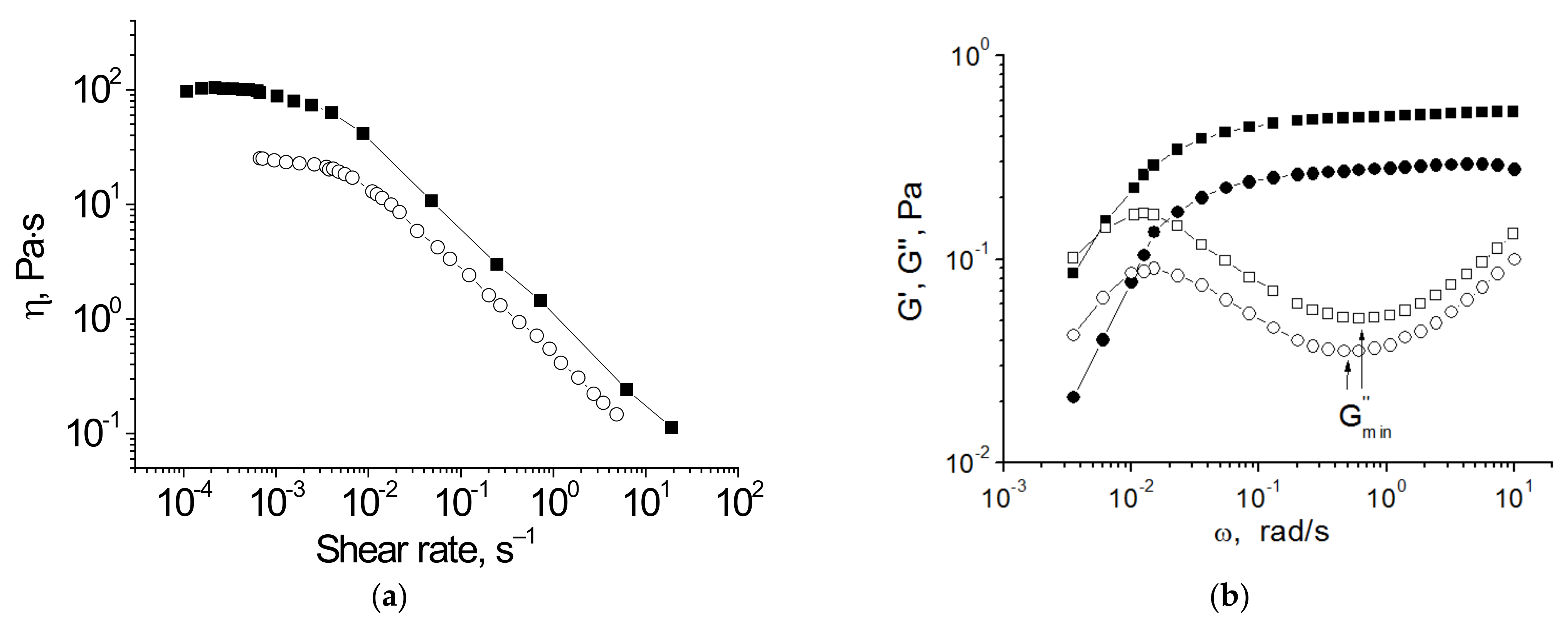

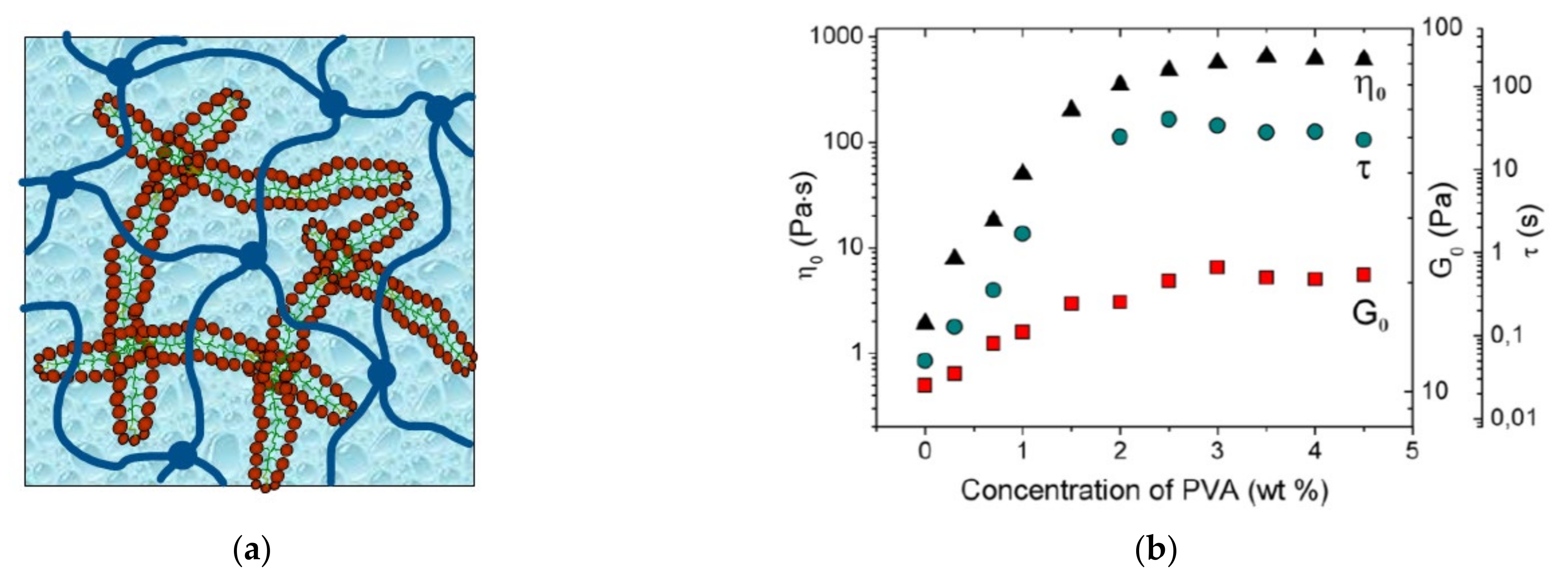
| Chemical Structure | Name | Advantages | Limitations | Refs. |
|---|---|---|---|---|
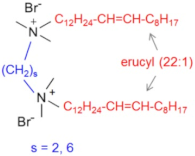 | EHAB 22:1-s-22:1 | Best characteristics are observed for s = 6: highly viscoelastic or gel-like solutions at high temperatures in the presence of salt (viscosity in the presence of NaSal at 110 °C is greater than 107 mPa·s) | no data | [56] |
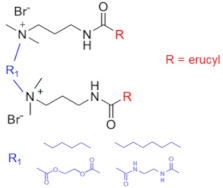 | C25-R1-C25 | High temperature resistance (up to 110–150 °C) | sensitivity to high salinity | [60,61] |
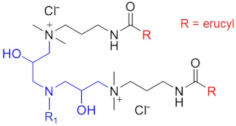 | VES-M (R1 = methyl) VES-E (R1 = ethyl) VES-P (R1 = n-propyl) | Best characteristics are observed for VES-M with smallest alkyl group in the spacer:
| sensitivity to high salinity | [57] |
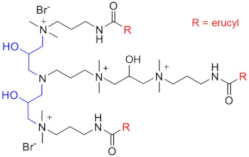 | VES-T |
| no data | [59] |
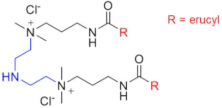 | JS-N-JS |
| sensitivity to high salinity | [58] |
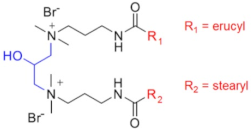 | YS-18 |
| no data | [65] |
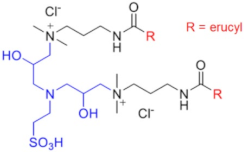 | VES-S |
| high temperature tolerance not studied in the work | [62] |
 | EDBS |
| no data | [63] |
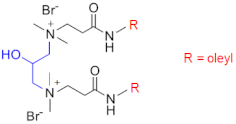 | GLO |
| high temperature tolerance not studied in the work | [64] |
 | GS |
| no influence of surfactants on the rheology of fluids reported | [66,67,68,69] |
Publisher’s Note: MDPI stays neutral with regard to jurisdictional claims in published maps and institutional affiliations. |
© 2021 by the authors. Licensee MDPI, Basel, Switzerland. This article is an open access article distributed under the terms and conditions of the Creative Commons Attribution (CC BY) license (https://creativecommons.org/licenses/by/4.0/).
Share and Cite
Shibaev, A.V.; Osiptsov, A.A.; Philippova, O.E. Novel Trends in the Development of Surfactant-Based Hydraulic Fracturing Fluids: A Review. Gels 2021, 7, 258. https://doi.org/10.3390/gels7040258
Shibaev AV, Osiptsov AA, Philippova OE. Novel Trends in the Development of Surfactant-Based Hydraulic Fracturing Fluids: A Review. Gels. 2021; 7(4):258. https://doi.org/10.3390/gels7040258
Chicago/Turabian StyleShibaev, Andrey V., Andrei A. Osiptsov, and Olga E. Philippova. 2021. "Novel Trends in the Development of Surfactant-Based Hydraulic Fracturing Fluids: A Review" Gels 7, no. 4: 258. https://doi.org/10.3390/gels7040258
APA StyleShibaev, A. V., Osiptsov, A. A., & Philippova, O. E. (2021). Novel Trends in the Development of Surfactant-Based Hydraulic Fracturing Fluids: A Review. Gels, 7(4), 258. https://doi.org/10.3390/gels7040258








